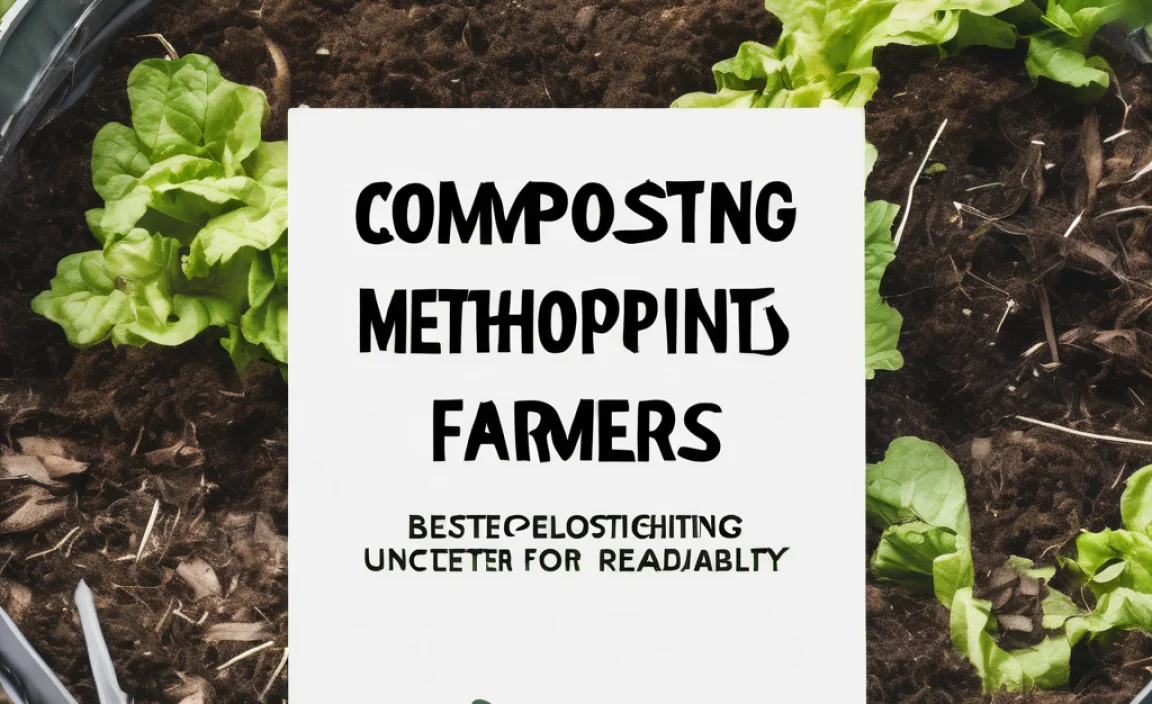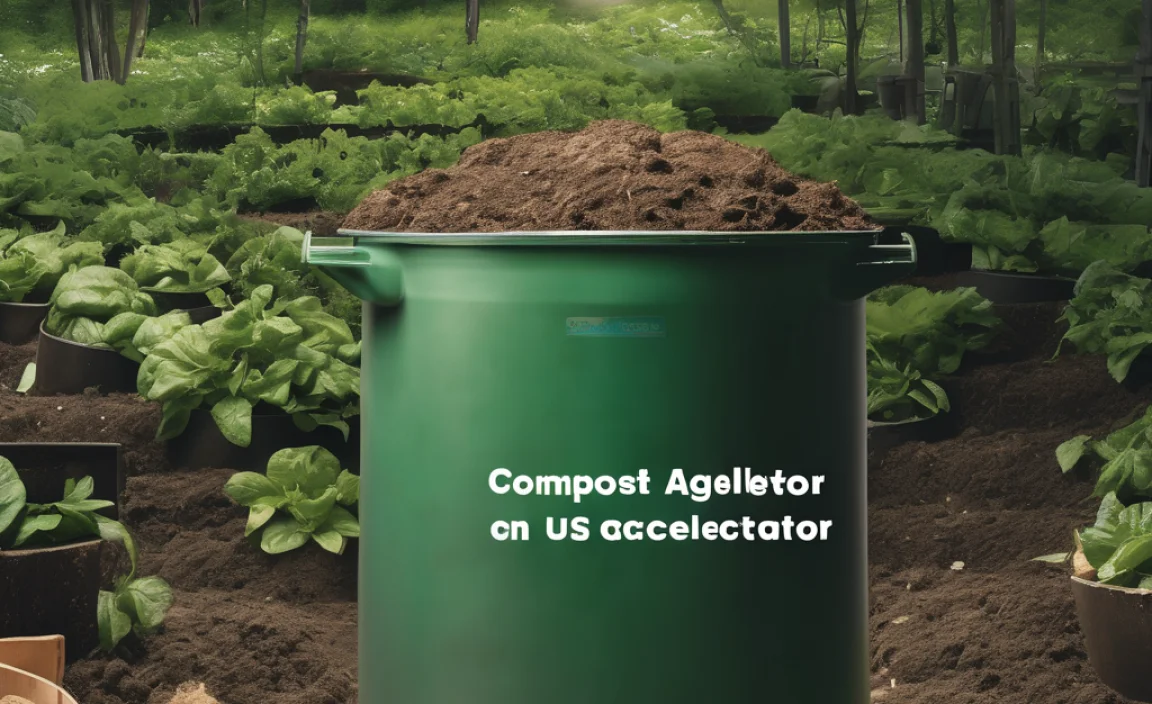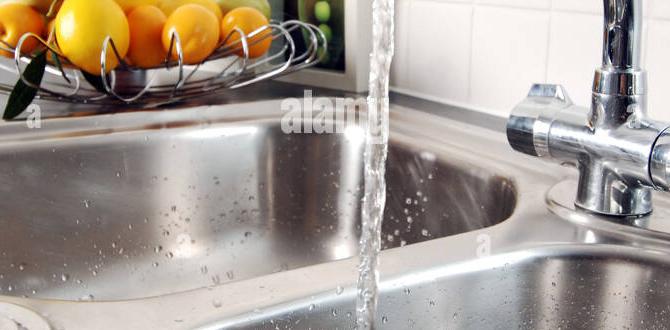Thinking about composting at your business? It might sound like a big undertaking, but it’s actually a fantastic way to reduce waste and even save some money. You might feel a bit overwhelmed knowing where to start, but don’t worry! We’re going to break it all down, step by step. Soon, you’ll be turning your business’s scraps into valuable compost.
Composting for Businesses: Your Essential Guide to Getting Started
Hey there! Troy D Harn here, and I’m excited to walk you through the world of business composting. Think of me as your friendly neighbor, showing you how to tackle this project with confidence. Many businesses think composting is too complicated or messy, but it’s really not! With a few smart tips, you can make it a smooth and successful part of your operations. We’ll cover everything from understanding what compostable materials are to setting up your system and keeping it running right. Let’s get started!
Why Your Business Should Embrace Composting
Composting isn’t just for home gardeners anymore. Businesses of all sizes are discovering the huge benefits of turning their organic waste into rich compost. It’s a win-win situation: you help the planet by diverting waste from landfills, and you can often cut down on trash disposal costs. Plus, many customers and employees appreciate seeing a business take steps toward sustainability.
Here are some of the top reasons your business should consider composting:
- Reduce Landfill Waste: Organic materials like food scraps and paper make up a significant portion of what businesses throw away. Composting diverts this from landfills, where it can produce harmful methane gas.
- Lower Waste Disposal Costs: The less trash you send to the landfill, the less you’ll pay in tipping fees and hauling charges.
- Create a Valuable Resource: Compost is a nutrient-rich soil amendment that can be used in landscaping, gardens, or even sold.
- Enhance Your Brand Image: Demonstrating a commitment to sustainability can attract environmentally conscious customers and employees.
- Meet Regulatory Requirements: Some areas are starting to require businesses to compost or separate organic waste.
- Improve Employee Morale: Many employees want to work for companies that care about the environment.
Understanding Compostable Materials for Businesses
The first step in any composting program is knowing what can actually go into the compost bin. This is crucial for ensuring your compost breaks down properly and doesn’t cause problems.
Generally, businesses can compost a wide range of organic materials found in kitchens, break rooms, and even offices. Here’s a quick breakdown:
“Greens” (Nitrogen-Rich Materials)
These materials are wet and usually break down quickly, providing nitrogen for the compost pile.
- Food scraps (fruits, vegetables, coffee grounds, tea bags, eggshells)
- Plate scrapings (avoiding excess meat/dairy in some systems)
- Grease trap waste (properly treated, if applicable)
- Green yard waste (grass clippings, fresh leaves)
“Browns” (Carbon-Rich Materials)
These materials are dry and provide carbon, helping to aerate the pile and balance the moisture.
- Cardboard (shredded, without glossy coatings or tape)
- Paper (shredded, unsoiled, avoid glossy paper like magazines)
- Paper towels and napkins (if not heavily soiled with chemicals)
- Dry leaves and small twigs
- Wood chips or sawdust (untreated wood)
Materials to Generally Avoid (or Compost with Caution)
Some items can cause issues in a composting system, attract pests, or take too long to break down. For a business setting, it’s often best to keep these out.
- Meat, fish, and dairy products (can attract pests and create odors, though some advanced systems can handle them)
- Oily or greasy foods
- Diseased plants
- Pet waste
- Treated wood
- Synthetic materials (plastics, styrofoam)
- Glass and metal
- Chemically treated paper or cardboard
Important Note: Always check with your local composting facility or waste management provider about what exactly they accept. Guidelines can vary!
Choosing the Right Composting Method for Your Business
The best composting method for your business depends on a few factors: the amount of organic waste you produce, your available space, budget, and whether you’ll manage it in-house or use a third-party service.
1. On-Site Composting
This involves managing the composting process directly at your business location. It requires space, equipment, and staff commitment.
a) Aerobic Composting (The Most Common Type)
This method relies on oxygen to break down organic matter. It’s generally faster and produces less odor than anaerobic composting.
- Bins or Piles: Simple, contained composting bins or open piles can work for smaller amounts of waste. They need regular turning for aeration.
- In-Vessel Systems: These are enclosed containers that help control temperature, moisture, and aeration. They can be more efficient and tidier, making them good for businesses.
- Windrows: Large, long piles of compost are turned regularly. This is more suited for businesses with very large volumes of organic waste, like restaurants or food processors.
Pros of On-Site:
- More control over the process and end product.
- Potential for significant cost savings on waste hauling.
- Stronger demonstration of sustainability to customers and staff.
Cons of On-Site:
- Requires space, equipment, and trained personnel.
- Potential for odor or pest issues if not managed correctly.
- Initial setup costs can be higher.
2. Off-Site Composting / Third-Party Services
This is often the easiest and most practical solution for many businesses. You partner with a commercial composting facility that collects your organic waste.
How it Works:
- Sign Up: Contact local composting services and choose a plan that fits your business needs.
- Collection: The service provides special bins for your organic waste, which they pick up on a regular schedule (e.g., weekly, bi-weekly).
- Processing: They transport the waste to their facility for professional composting.
Pros of Off-Site:
- Minimal effort required from your business.
- No need for space or equipment.
- Professional management ensures proper composting and avoids odor/pest issues.
- Often the most cost-effective option for smaller to medium businesses.
Cons of Off-Site:
- Less direct control over the process.
- May not offer the same level of brand messaging as visible on-site composting.
- Ongoing service fees.
Recommendation: For most businesses just starting out, especially those with moderate waste volumes, using a third-party composting service is the simplest and most reliable way to begin. If you have very high volumes or specific sustainability goals, on-site might be worth exploring with proper planning.
Setting Up Your Business Composting System: Step-by-Step
Whether you’re going with an on-site system or a third-party service, a well-planned setup is key to success. Here’s how to do it:
Step 1: Assess Your Waste Stream
Before you do anything, figure out how much organic waste your business generates and what types it includes. Conduct a waste audit. For a week, track all the food scraps, paper products, and other compostable materials your business produces. This will help you choose the right bin sizes and collection frequency (if using a service) or the right composting method and equipment (if going on-site).
Step 2: Designate Collection Points
Set up convenient collection bins for compostable materials in key areas. These include kitchens, break rooms, cafeterias, and even restrooms (for paper towels).
- Label Clearly: Use clear signage on bins indicating what can and cannot be composted. Pictures are great for easy understanding!
- Use Appropriate Bins: Small countertop bins are good for collecting scraps, while larger bins may be needed for general waste areas.
- Keep them Clean: Regularly clean your collection bins to prevent odors and pests.
Step 3: Educate Your Staff
This is probably the most critical step for any composting program. Your employees are the ones who will be sorting the waste.
- Training Sessions: Hold brief, clear training sessions on what items are compostable and how to sort them.
- Visual Aids: Post simple posters or infographics near waste bins showing examples of compostable and non-compostable items.
- Designate a “Compost Champion”: Appoint an enthusiastic employee to help answer questions and encourage participation.
- Make it Easy: The easier you make it for staff to compost, the more likely they are to do it correctly.
Step 4: Choose and Implement Your Composting Method
If using a third-party service:
- Research local commercial composting companies.
- Compare pricing, services, and accepted materials.
- Schedule bin delivery and set up a collection routine.
- Ensure staff know which bins to use for compostables.
If setting up on-site composting:
- Select your system (bin, in-vessel, etc.) based on your waste volume and space. Visit resources like the EPA’s composting page for general principles.
- Install your composting system in an appropriate location – usually well-ventilated and accessible, but away from public view if aesthetics are a concern.
- Gather necessary tools: pitchforks or aerators for turning, thermometers to monitor temperature, and potentially a water source.
- Establish a routine for adding materials, turning the pile, and monitoring moisture and temperature.
Step 5: Monitor and Adjust
Once your system is in place, keep an eye on it. Are bins being used correctly? Are there any issues with odors or pests? Is the compost breaking down as expected (if on-site)?
- Gather Feedback: Ask staff for suggestions or report any problems.
- Regular Audits: Periodically check what’s ending up in the compost bins to identify any recurring sorting mistakes.
- Troubleshoot: If you encounter problems, research solutions or consult with your composting service provider.
Essential Tools and Equipment for Business Composting
The tools you need will vary depending on whether you’re composting on-site or using a service. Off-site services will handle all the processing equipment. For on-site composting, consider these:
For Collection & Transport (On-Site or Off-Site Prep)
- Clearly Labeled Bins: Various sizes for different locations (kitchen, break room, office).
- Airtight Containers: Smaller bins for kitchens can help control odors before they go into the main collection bin.
- Small Carts or Dollies: To easily move full bins to a central collection point or compost area.
For On-Site Composting Systems
Small to Medium Scale (Bins, Tumblers, In-Vessel)
- Compost Bin(s): A sturdy, well-ventilated enclosed bin is often ideal for businesses to manage odors and pests. Many commercial units are available.
- Aeration Tools: A compost aerator or pitchfork for turning the material.
- Watering Can or Hose: To maintain proper moisture levels.
- Thermometer: A compost thermometer is helpful to monitor the internal temperature of the pile, ensuring optimal decomposition.
Large Scale (Windrows)
- Front-End Loader or Skid Steer: Essential for turning large compost piles efficiently.
- Water Sprayer: For keeping large windrows moist.
- Screening Equipment: To sift the finished compost for a finer texture.
Tip: If you’re unsure about investing in on-site equipment, start with a pilot program or a third-party service to test the waters.
Maintaining Your Business Composting Program for Long-Term Success
Starting a composting program is one thing; keeping it running smoothly is another! Consistent effort is key.
1. Consistent Staff Training and Reinforcement
New employees will join, and habits can slip. Make composting education a part of your onboarding process and periodically refresh training for all staff. Use visual cues like posters and bin labels to provide ongoing reminders.
2. Regular Bin Cleaning and Maintenance
This is crucial, especially for bins that are frequently handled or contain food waste. Clean bins prevent odors, deter pests, and make the program more appealing to users. If using a third-party service, ensure they provide clean bins or a plan for their cleaning.
3. Monitoring and Feedback Loop
If you’re managing it on-site, regularly check your compost pile’s temperature and moisture. If using a service, communicate with them about your waste volume and any observed challenges in your collection areas. Encourage employees to report issues or provide suggestions anonymously if they prefer.
4. Addressing Contamination
Contamination (non-compostable items in compost bins) is an enemy of any composting program. If you see consistent errors, it might indicate a need for more targeted education. For on-site systems, removing contaminants before they break down can save your batch. For off-site services, high contamination can sometimes lead to extra fees or rejection of materials.
5. Evaluating and Optimizing
Periodically review your program’s effectiveness. Are you diverting as much waste as you hoped? Are there ways to make the system more efficient? For instance, could you collect specific types of waste (like coffee grounds) in larger quantities or explore on-site options if current service costs are high?
Composting Best Practices: What Makes it Work?
Whether you’re a composting guru or a complete beginner, these best practices will help you achieve successful, odor-free composting.
The Ideal Carbon-to-Nitrogen Ratio
For efficient decomposition, compost needs a good balance of “greens” (nitrogen) and “browns” (carbon). A common target ratio is about 25-30 parts carbon to 1 part nitrogen. This often translates to roughly 2-3 times more “browns” by volume than “greens.”
Table: Balancing Greens and Browns
| “Greens” (Nitrogen Source) | “Browns” (Carbon Source) |
|---|---|
| Fruit and vegetable scraps | Shredded cardboard and paper |
| Coffee grounds and tea bags | Dry leaves |
| Grass clippings | Sawdust (untreated wood) |
| Plate scrapings (mostly plants) | Straw or hay |
Why it matters: Too many greens can lead to a wet, smelly, anaerobic pile. Too many browns slow down decomposition. A good balance keeps things healthy.
Moisture Management
Compost needs to be damp, like a wrung-out sponge. Too dry, and decomposition slows. Too wet, and it can become anaerobic and smelly.
- Check Moisture: Squeeze a handful of compost. A few drops of water should come out.
- Add Water: If too dry, add water.
- Add Browns/Aerate: If too wet (and compacted), add more dry “brown” materials and turn the pile to improve airflow.
Aeration (Oxygen Supply)
Microorganisms that break down organic matter need oxygen. Turning your compost pile regularly (on-site) or ensuring that your selected method allows for airflow is vital.
- Regular Turning: For open piles or bins, turning every 1-2 weeks significantly speeds up the process and prevents odors.
- In-Vessel Systems: Many have built-in aeration or are designed to allow easy airflow.
- Avoid Compaction: Don’t let your compost pile become a dense, solid mass.
Temperature Control (For On-Site)
An actively composting pile will heat up, which is good! High temperatures (130-160°F or 55-70°C) kill weed seeds and disease pathogens and speed up decomposition. While not always critical for home composting, it’s a sign of a healthy, active pile.
- Monitor with a Thermometer: Insert a compost thermometer into the center of the pile.
- Adjust as Needed: If a pile isn’t heating up, it might need more greens or turning. If it’s too hot for too long, it might need more aeration or water.
Particle Size
Smaller pieces break down faster. Shredding cardboard, breaking up large vegetable peels, and chopping up tougher materials will help everything decompose more quickly and evenly for on-site systems.
Cost Savings and ROI for Businesses
Composting isn’t just an environmental initiative; it can be a smart financial decision for your business.
Waste Hauling Fees
The most immediate cost saving comes from reducing the volume of trash sent to landfill. Landfill tipping fees and collection costs can be significant. By diverting organic waste, you can often reduce the number of trash pickups or move to a smaller dumpster, saving you money each month.
Potential Revenue Streams
If you compost on-site and produce high-quality compost, you might be able to sell it to local landscapers, gardeners, or even municipal programs. This turns a waste product into a revenue generator.
Brand Value and Customer Loyalty
In today’s market, consumers are increasingly conscious of a company’s environmental impact. A visible and effective composting program can enhance your brand image, attract eco-conscious customers, and foster loyalty. This intangible benefit can translate into increased sales and positive word-of-mouth.
Employee Attraction and Retention
Many people want to work for companies that align with their values. A strong sustainability policy, including composting, can make your business a more attractive employer. It can also boost employee morale and engagement.
Calculating Your ROI
To calculate your return on investment (ROI), consider:
- Costs: Initial setup (bins, equipment), ongoing service fees (if applicable), staff training time, any maintenance.
- Savings: Reduced waste hauling bills, potential revenue from selling compost.
- Intangible Benefits: Improved brand image, customer loyalty, employee satisfaction (these are harder to quantify but very real).
A simple calculation could be: (Total Annual Savings + Revenue) / Total Annual Costs. Even a modest percentage can justify the program’s existence.
Legal and Health Considerations for Business Composting
While composting is generally safe and beneficial, it’s important to be aware of any regulations and to manage your program responsibly to avoid health and safety issues.
Local Regulations and Permits
Depending on your location and the scale of your composting operation, you might need to comply with local ordinances, environmental regulations, or obtain permits. This is especially true for larger on-site composting operations.
- Check with your local government: Your city or county’s waste management or environmental department is the best place to start.
- Commercial Composting Services: If you use a third-party service, they will be responsible for ensuring compliance at their facility.
For general composting guidelines from a government perspective, the EPA’s resources on composting regulations can be a useful starting point.
Odor and Pest Management
Improperly managed compost can attract pests (rodents, flies) and create unpleasant odors, which is bad for business. Proper management is key:
- Proper Aeration and Moisture: These are the primary defenses against odor.
- Containment: Using bins or enclosed systems can help.
- Avoid Problematic Materials: Keep meat, dairy, and oily foods out of compost unless using a system specifically designed to handle them.
- Prompt Collection: Regular emptying of collection bins reduces attractants for pests.
Worker Safety
If you are composting on-site, ensure that staff handling compost materials are aware of potential hazards. This includes:
- Lifting: Bins can be heavy. Use proper lifting techniques or mechanical aids (carts, dollies).
- Tool Safety: Safe use of pitchforks and other turning tools.
- Hygiene: Provide handwashing facilities and encourage good hygiene practices after handling compost materials.
- Personal Protective Equipment (PPE): Gloves might be advisable, especially when starting out or handling particularly wet materials.
Conclusion: Start Composting and Reap the Rewards!
Diving into composting for your business might seem like a big step, but as you can see, it’s a very achievable and incredibly rewarding endeavor. Whether you choose the simplicity of a third-party collection service or the hands-on approach of an on-site system, the benefits are clear. You’ll be reducing your environmental footprint, potentially cutting costs, and enhancing your business’s image as a responsible and forward-thinking organization.
Remember, education is key. Make sure your team understands why composting is important and how to participate effectively. Start with a plan, set up convenient collection points, and don’t be afraid to ask for help from service providers or local resources. With a little effort and consistent practice, your business composting program will become a natural, beneficial part of your daily operations. You’ve got this!
Frequently Asked Questions about Business Composting
Q1: How much organic waste can my business expect to divert with composting?
A: This varies greatly by business type. Restaurants, cafeterias, and food service providers can often divert 50-80% of their total waste stream. Offices with break rooms might divert 10-30% mainly from food scraps and paper products. A waste audit is the best way to get an accurate estimate for your specific business.
Q2: Will composting create a bad smell at my business?
A: A well-managed compost system should not produce offensive odors. Unpleasant smells usually indicate a lack of oxygen (anaerobic conditions), too much moisture, or the wrong materials being added. Regular turning, maintaining the right moisture balance, and using a mix of greens and browns are key to an odor-free setup. Using a third-party service also mitigates this risk.
Q3: What’s the difference between composting at home and composting for a business?
A: The main differences are scale, volume, and the types of waste generated. Businesses often produce larger volumes and may have different waste streams (e.g., grease trap waste for restaurants). Management also differs; on-site business composting might require more robust systems and staff training compared to a small backyard bin, or it can be fully outsourced to a commercial service.
Q4: How long does it take to get a composting program up and running?
A: If you opt for a third-party service, it can be surprisingly quick – often just a few weeks from signing up to receiving your bins and starting collection. Setting up an on-site system takes longer, potentially a few months, depending on the complexity of the chosen method, equipment acquisition, and staff training implementation.
Q5: Can my business compost all food waste, like meat and dairy products?
A: This depends heavily on your composting method. Most basic backyard or small-scale systems are not ideal for meat, dairy, or oils due to odor and pest concerns. However, large, professional composting facilities and some advanced commercial in-vessel systems are designed to handle these materials. Always check with your chosen composting service or facility about their specific acceptance policies.
Q6: Is composting expensive for a business?
A: It depends on your approach. Using a third-party service involves ongoing fees, but these are often offset by savings in trash hauling costs. On-site composting has upfront equipment costs and ongoing labor/maintenance, but can lead to greater savings or even revenue if managed well. Many businesses find that the overall cost is comparable to or less than their current waste disposal methods.

I am passionate about home engineering. I specialize in designing, installing, and maintaining heating, ventilation, and air conditioning systems. My goal is to help people stay comfortable in their homes all year long.




